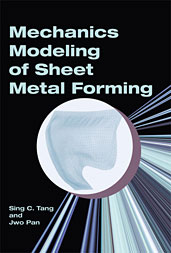Technical Paper
A Failure Criterion for Stretch Bendability of Advanced High Strength Steels
2006-04-03
2006-01-0349
Studies in an Angular Stretch Bend Test (ASBT) have demonstrated that the failure location moves from the side wall to punch nose area. This occurs as the R/T ratio decreases below a certain limit and applies to most low carbon steels with the exception of Dual Phase (DP) steels. Such behavior in DP steels indicates that bending effects have a severe impact on the formability of DP materials. Therefore, the traditional criterion using the forming limit curve (FLC) is not suitable to assess the formability at punch radius areas for DP steels due in part to its uniqueness of unconventional microstructures. In this paper, a new failure criterion, ‘Bending-modified’ FLC (BFLC), is proposed by extending the traditional FLC using the “Stretch Bendability Index” (SBI) concept for the stretch bendability assessment.

